Disclaimer: My summary of what people said or should have said. Nothing is a quote unless in quotes. The Monday committee meetings are here.
The wrap up (Note: I skipped out before the votes on some of these, but I assume the board rubber-stamped whatever Lillis and Wilhelms put in front of them, as usual):
- The board voted 12-0 to spend $100K of other people’s money on a bonus for President Schill – and gave him a retention package with a fat retirement deal – teach two courses a year for $450K. Schill promised to donate $75K back to UO for scholarships.
- The board re-elected Charles M. Lillis as Chair to a 3rd term, since no one else will take on the job of being Phil Knight’s amanuensis. Avoided mention of his ERISA lawsuit settlements and the ~$175M he and the other WaMu board members had to pay out after they led it to the largest financial bankruptcy in US history. Video here. “This time they even blamed teachers.”
- The board avoided any substantive discussion of what work they might do to carry through with the promises Lillis, Knight, and the other backers of SB270 and UO independence made about stabilizing UO’s funding. As Henry Ford said, “Thinking is the hardest work there is, which is probably the reason why so few engage in it.”
- VP’s Jamie Moffitt and Kevin Marbury set the stage for ensuring that ASUO is on board with the next round of tuition increases, and that they will result in only minor student demonstrations and minimal public embarrassment to the Trustees. They also discussed a proposal to offer a guaranteed tuition rate for new students over their 4 years.
- The board voted to issue $120M in debt to finish constructing the Athlete Village for Phil Knight’s Oregon21 T&F championships. Bonds to be repaid with higher room and board charges for UO students.
KEZI has a report on Pres Schill’s bonus, here: https://www.kezi.com/content/news/University-of-Oregon-President-to-potentiall-recieve-100K-bonus-566004431.html:
Chair Chuck Lillis and Vice Chair Ginevra Ralph are recommending the approval of the bonus based on Schill’s performance.
“He’s already making $700,000, why does he need that $100,000 bonus?” said student Daisy Caballero.
Schill is actually making $720,000 a year, and the bonus would come just weeks after graduate employees were fighting for basic benefits and a livable wage. …
The Daily Emerald reports the Board then voted 12-0 for the $100K bonus, of which Schill has generously promised to donate $75K for scholarships. This will leave him with about $13K after tax, which may not be worth the bad will.
That said our board has done more wasteful things, like voting a few years ago for a contract for the Duck’s Mark Cristobal which so far this year has given him $1M in bonuses to top off his ~$3M pay:
And speaking of philanthropy, while the Duck athletic department’s donations to the Oregon Community Fund Drive are up 50% over last year, that’s off of a $50 base – total, for a department with many, many people making more than $250K.
2018:
2019:
Full Board of Trustees, Tuesday December 10, 2019 | 9:30 a.m. Live here: https://media.uoregon.edu/channel/
– Public comment (Sorry, I spilled my coffee and missed some of the public comments.)
Former Trustee Kurt Willcox speaks against $100K bonus for Pres Schill noting he is already the 38th highest paid public president. Presided over large tuition increases, a deficit, cuts to LERC and museums, and labor unrest with the GTFF etc.
Grad Student Johnny Saunders walks the board through the history of the $120M residence hall bond deal they are about to approve, referring to previous board minutes and reports commissioned by the board to show that this proposal is motivated by the desire to build an athlete village for the 2021 IAAF meet, not by need for new undergraduate housing. Thanks to Jonny for providing his notes and links:
– Finance and facilities committee meeting, December 2nd, 2015:
https://trustees.uoregon.edu/sites/trustees2.uoregon.edu/files/agenda_and_materials_-_ffc_-_120215_-_updated.pdf
page 32
“The findings from the feasibility and market demand study final report clearly state that the university of oregon should […] renovate rather than replace bean, hamilton, or walton. the findings show that the cost of replacement would create prohibitively expensive room and board rates relative to renovation.”
– Still described as ‘hamilton renovation” at meetings on
– December 1st 2016
– December 7th, 2017
– finance and facilities committee june 7th 2018
meeting slides: https://trustees.uoregon.edu/sites/trustees2.uoregon.edu/files/ffc_6.7.18_meeting_packet.pdf video: https://lib-media.uoregon.edu/media/UOBOT/2018/20180607BOT-FAFC.mp4
-Introduced with no further reports,
– vague nonempirical statements about need for plan
-only tangential reference to feasibility reporty
– two reasons for project presented
housing demand
recruitment
with reference to the 2011 residence hall feasibility and market demand study:
https://cpfm.uoregon.edu/sites/cpfm2.uoregon.edu/files/uo_rhfmdstudy_101211_0.pdf
housing demand:
– feasibility and market demand study estimated 23,198 undergrads in 2021
– for that we would need 5100 total beds
– but currently there are 18,903 undergrads
– should be low/no pressure for housing
recruitment:
– in FFC presentation: ‘we know what housing students want’
– but the feasibility study: “Moreover, the students in the focus groups in the Residence Hall Feasibility and Market Demand Study did not express alarm or disdain over their existing housing. They said the housing is what they expected to live in as freshmen. That the housing was not brand new was of secondary importance.”
– 5/8 of their focus group said cost was the primary reason they chose UO
What changed in the spring of 2018?
– price tag
– end-date of first phase: a new building in summer 2021 instead of a renovated Hamilton in 2022
This board is derelict in its duty to pass this bond.
– Board has not asked why it suddenly costs $500k per new bed
– housing demand is far lower than expected
– cost of attending consistently increases, pricing students out of an education
– student’s in both the board’s focus group and ASUO explicitly say they don’t want this project:
– ASUO statement on tuition increases says too much money spent on giving lavish experience: https://www.oregon.gov/highered/about/Documents/Commission/COMMISSION/2019/13%20June%202019/8.4%20AI%20Final%20Recommendation%20Report%20UO%20tuition%20approval%20request%20updated%206-11-19.pdf
– no additional reports have been given
– no firm details on how much housing fees will increase
– And still pass along an unadvertised potentially double digit percent increase in cost to a generation of UO students
Two members of the OA Council (sorry I missed names) speak to the board about their 2018 climate survey and the issues it raises regarding salary and respect for their work. The OA’s are UO’s core managers, the OA website is here.
Community member David Igl reiterates his well known views on the Dunn denaming and the KKK. Say what you will about Mr. Igl, he is not afraid to speak unpopular and factually questionable views to a hostile audience.
Community member and student Joe Tindhal states that UO is infected by “social justice snowflakes” and “students leave dumber than when they arrive”. He also notes a decline in Star Wars merchandise sales. Given that our board is mostly composed of rich old business people, this seems more directed at the students than the board, and they exercise their First Amendment right to make their disagreement known while respecting his right to speak.
Lillis calls a 5 minute recess.
1. ASUO and University Senate Reports
-ASUO President Sabinna Pierre
Not present.
-University Senate President Elizabeth Skowron
Despite Chuck Lillis’s best hopes the UO Senate survived Harbaugh’s presidency, and with Skowron in charge he will have to find a new excuse for subverting shared governance. She delivers a crisp, fact-based report:
She also arranged meetings with select faculty and the board over lunch. Lillis is eating this stuff up.
2. President’s Report & an Overview of the Last Five Years: President Michael, Schill
Presumably this will be part retrospective, and part supporting material for his next job application.
5 years and he’s late turning it in? Still nothing posted. OK, just got the link, here. How can the board be expected to do its due diligence on his $100K bonus and lucrative retirement deal when they don’t get his brag sheet til the day of the meeting?
Remarks:
Pres Schill notes that it’s 5 years since the UO Board took power. Lots of chaos. Lots of work and money was spent recreating the functions previously done by the OUS board. Schill notes that when he arrived Coltrane could not tell him how many faculty we have. [As union treasurer, I can report that IR still cannot figure that out on a timely basis.]
Gives a shout out to the faculty – careful to include the NTTF/Careers. I wonder if this means he’ll agree to raising their salary floor from $38K for 8 classes a year?
Rebuilt his relationship with the university senate [Is this the part where he gives me some credit? Nope. Good, this would blow my street-cred.]
Replaced UO’s semi-transparent and easily gamed RCM model with BradShelton’s opaque budget model, which centralizes faculty hiring with a committee run by Brad. This will allow UO to move faculty lines from the declining humanities to the sciences. Says this will promote excellence – as measured by Brad Shelton’s metrics, of course.
Funding:
State funding up substantially – thanks to the state, not UO. Endowment up 37% over 5 years. This seems low – the S&P is up more than 50%. Raised $374M for scholarships – I assume that’s mostly promises. 33% of fund drive money is for athletics. I think that excludes Hayward, etc.
Academics:
Enrollment, not so good. And no, this slide is not in his report:
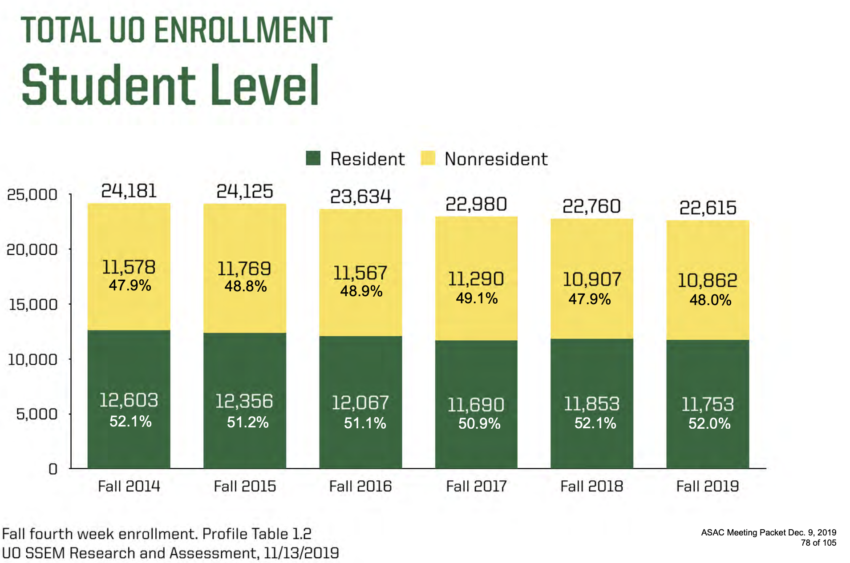
Worked with the Senate to redo student evaluations, worked with faculty on new academic programs for undergrads, etc.
Student Access:
Scholarships to Oregonians up by 37%. [But then tuition is up, which offsets much if not all of this.]
Student success:
Gives CAS – but not Andrew Marcus – credit for Tykeson, which so far is a money pit for everyone but Ikea.
Diversity: Lots of window-dressing. Still having problems retaining minority faculty. Need a new VPEI pretty soon, maybe that will help?
Student Experience:
There’s no doubt that the physical environment has improved dramatically since I came here in 1995. E.g. new EMU, paid for by student tax. Not so good for faculty, though I did get window AC for my PLC office, which helps when my students start sweating over calculus questions.
Sexual Violence: We’ve improved services, and GC Kevin Reed has done a great job hiding the sorts of incidents that got President Gottfredson fired. So far.
Athletics: “We’re” going to Rose Bowl, We’ll have a big junket for the Deans and JH senior admins and their spouses so they can recruit students. Sure, that’ll work great.
If you want to see who else took this previous junket, there’s video here and photos here.
For a more sober analysis of the effects of football on enrollment, here’s one of many recent papers:
Colleges and universities face pressure to maintain enrollments in a time of demographic shifts in the college-going population and reductions in state funding. One indicator of successfully maintaining enrollments is the percentage of accepted students who matriculate—the enrollment yield. Factors known to contribute to yield include school size, cost, research, and reputation. Of interest in the present study is the import of academic reputation as measured by U. S. News and World Report rankings and social reputation as measured by designation as a ‘party school’ relative to accomplishments of the school’s high-profile athletic teams. I use a 21 year panel to model yield for all institutions competing at the highest level of intercollegiate athletics. The results show that yield rates consistently respond to USNWR rankings, but being named a party school has a more sporadic influence. Athletic success has little effect on a school’s enrollment yield. The findings suggest that the signals sent by academic rankings are stronger and better received than the signals sent by social or sports accomplishments.
Challenges: Pres Schill comes close to saying out loud that Board has not delivered on the financial stability that was promised. Points out that philanthropy is tricky.
It is. When Phil Knight gave the money for Hayward, Schill could have made sure that he paid to replace the parking and the $2.3M for utility hookups. He didn’t, so now the UO staff and students are stuck with the bills. Very tricky.
Questions from the Board?
Nope. No preparation, no questions, no due diligence.
3. Tuition-Setting Process and Guaranteed Tuition Discussion: Jamie Moffitt, Vice President for Finance and Administration; Kevin Marbury, Vice President for Student Life; Roger Thompson, Vice President for Student Services and Enrollment Management
This is the second time around for the tuition guarantee proposal, which is going nowhere for reasons that should be obvious to anyone who read the version three years ago. I assume it’s on the agenda so the trustees can have something that sounds consequential to ask questions about. It’s not, so I’ll skip it – although Thompson is *very* enthusiastic for its potential to help with recruiting. Of course as he suggests – honesty is one of his many charms – it will also eliminate student protests at board meetings over tuition increases, which might be enough to encourage our trustees to kick in the millions that will be needed to implement it.
Bragdon asks why, if this is such a great idea, more schools aren’t doing it. Moffitt explains they are, the presentation just had a short list.
Ralph notes that the last time they heard this presentation Thompson was a lot less positive about it. Why the new enthusiasm? He’s worried the UC system will do it first.
Ford notes that a reserve will be crucial in case of an enrollment decline, or drop in state funding. Asks if the HECC is qualified to evaluate this sort of program. [They certainly are. I’m on the HECC’s SSCM working group, and I’ve found the HECC staff to be quite good. on par with Thompson’s people. Certainly more knowledgeable about higher ed issues than, say, Brad Shelton. ]
Board catches Thompson’s infectious enthusiasm, tells TFAB to start looking at guaranteed tuition.
The real action here is on the TFAB and the coming tuition increases. VP Marbury presents on the state-mandated tuition setting process. For some examples of the propaganda – and lies – that Moffitt and Marbury dish up to our students during this process, check their website here:
OK, so we can’t blame the coaches, so it must be the faculty’s fault. Interestingly, Moffitt and Marbury – or whoever is strategically communicating for them – are a little confused about whether to blame the faculty union’s labor cartel or free market forces:
They could also blame double-dippers like VP Brad Shelton, who’s now collecting PERS and a fat UO salary. Last year, with SB1049, the legislature decided to make state agencies pay PERS contributions on these salaries, which had been exempt.
Interestingly, the overall impact of PERS this year is a *reduction* in costs, because of reductions in bond costs and because as UO’s Tier 1 employees retire UO no longer has to pay into PERS for them. (Except now while they keep working, as with Shelton or TRP faculty).
Back of the envelope and ignoring the elasticity of demand, a 1% increase in tuition brings in about $750K from in-state students, and about $2.5M from out of state.
So balancing the budget could be done as follows, while keeping the tuition increase to 2%;
-
- $5M saved by eliminating hidden athletic subsidies
- $5M saved by dropping baseball, men’s golf and tennis.
- $3M saved by reducing the subsidy for law school tuition
- $2M saved by reducing consulting costs and getting rid of a few lawyers and strategic communicators.
- $6.5M in new revenue from a 2% tuition increase.
That’s more than enough to make the $19M nut.
Needless to say this is not the proposal Moffitt and Marbury will guide the students toward in the next few months of TFAB meetings. Instead UO will push for 4.9% tuition increases, just below the level that triggers HECC review, and they will continue to claim that the athletics budget is untouchable, and that the faculty, state, PERS, and China are to blame for the increases.
Meeting Recessed for Lunch with Students
I’m not sure I’ll live blog the rest of this, video is at https://media.uoregon.edu/channel/ (I didn’t. Enough is enough. See top for summary.)
4. Resolutions and Seconded Motions from Committee (Actions)
4.1 Seconded Motion from FFC – Bond Issuance Authorization: Ross Kari, FFC Chair
4.2 Seconded Motion from EAC – Board Officers: Peter Bragdon, Trustee
4.3 Resolution Re Presidential Bonus and Contract Amendment: Chuck Lillis, Chair
5. Academic Area in Focus – Media Center for Science and Technology: Ellen Peters, Philip H. Knight Chair and Director of the SOJC’s Media Center for Science and Technology
Sorry, but this is just too glossy and self-promoting to take seriously.
Adjourn
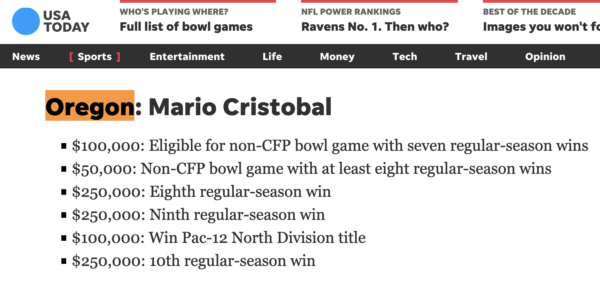
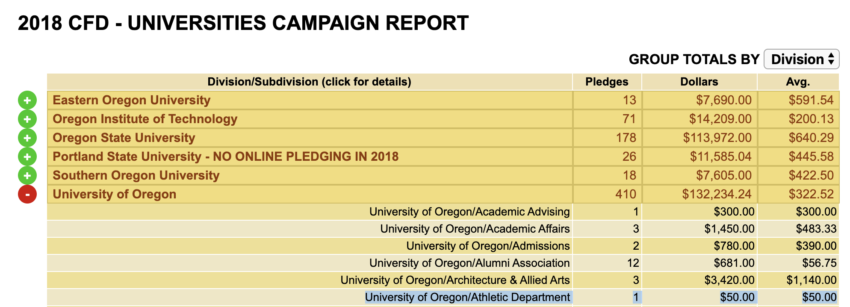

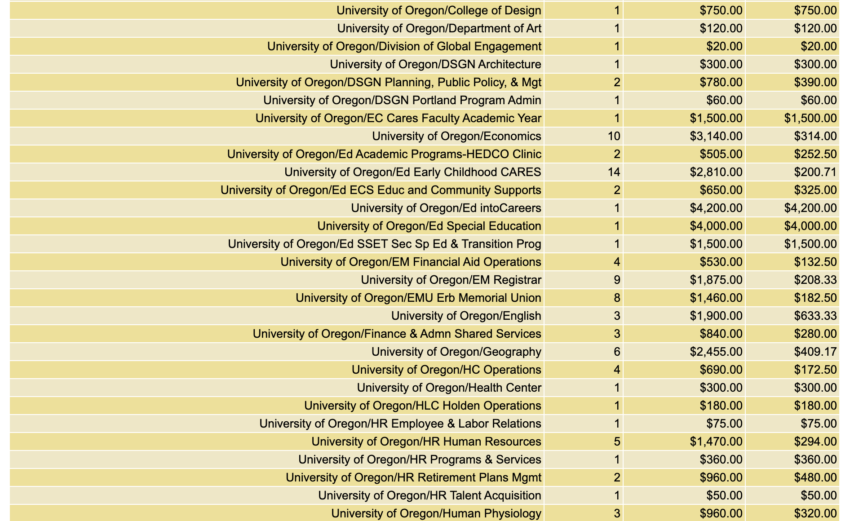
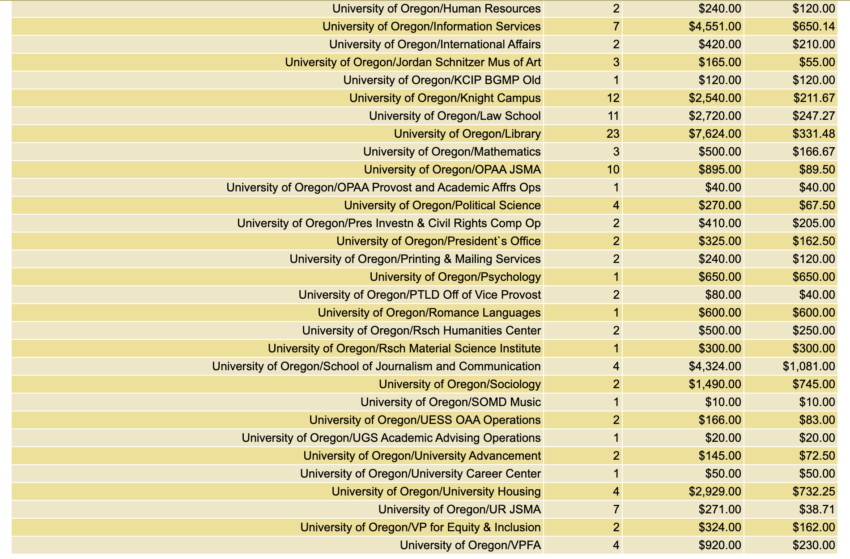
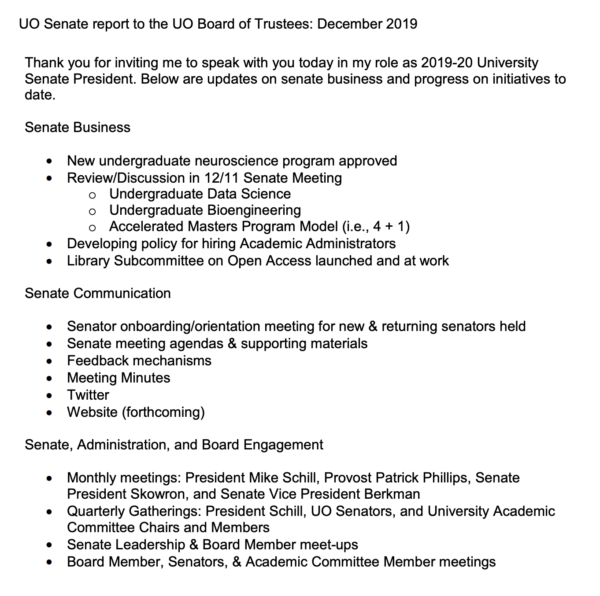
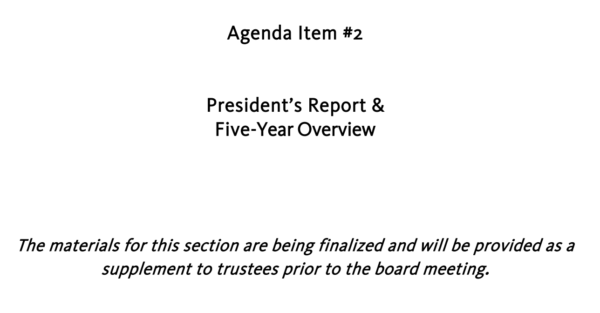
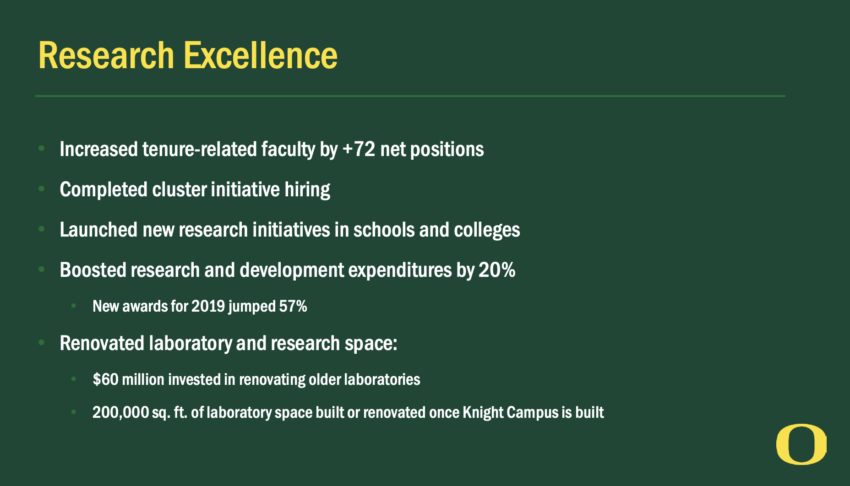
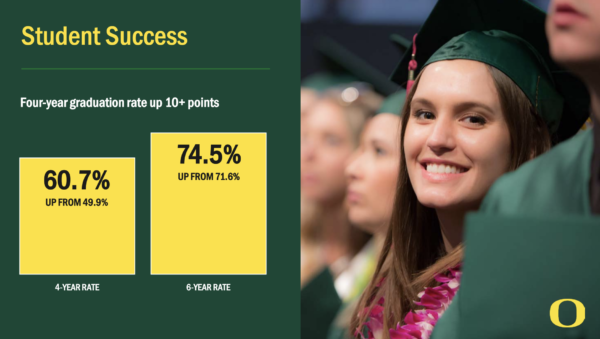

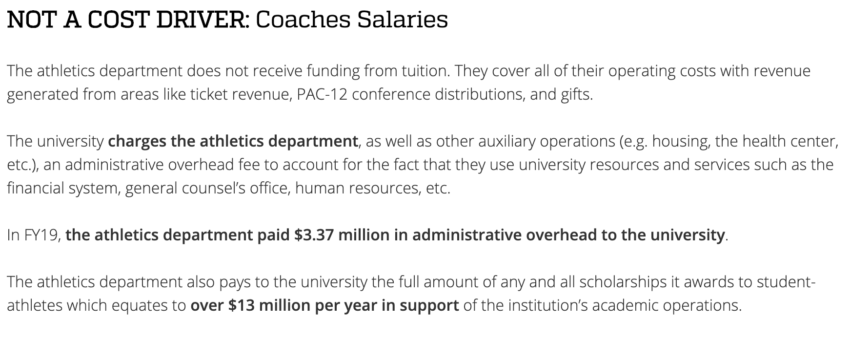
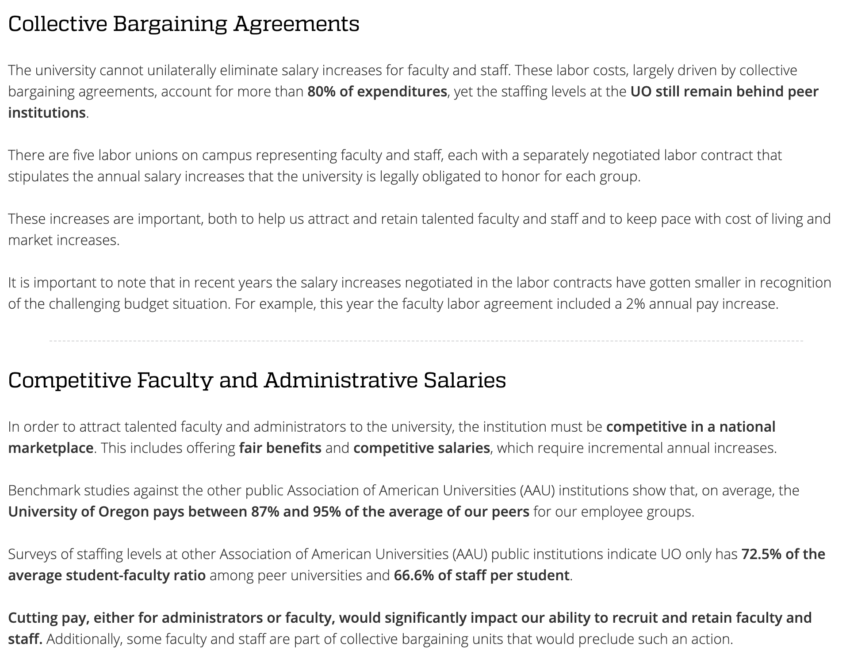
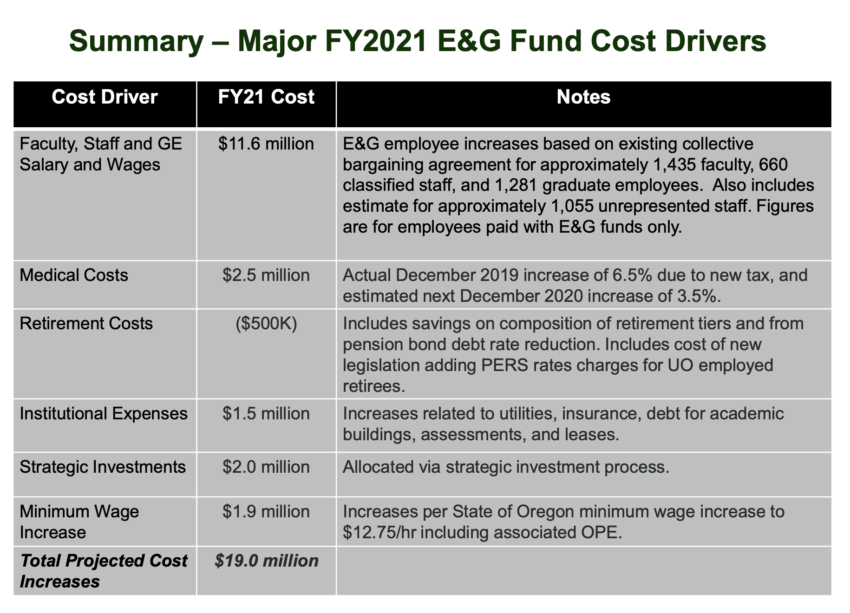
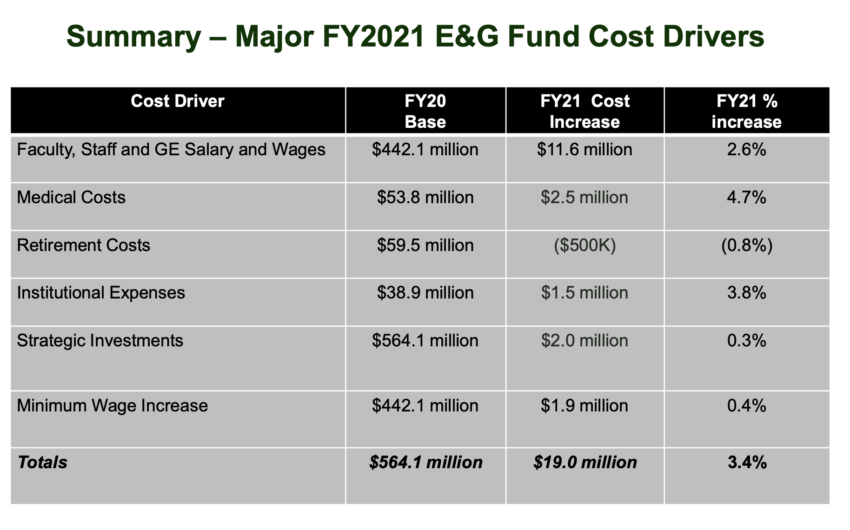
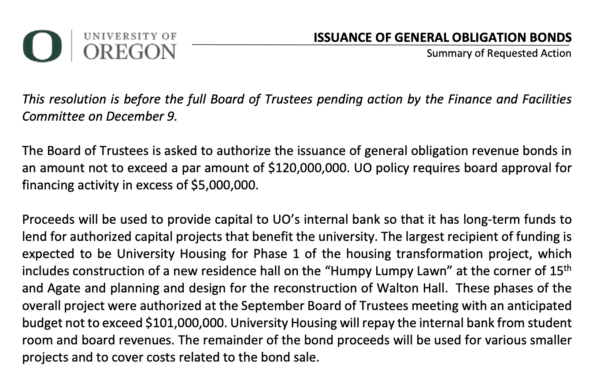
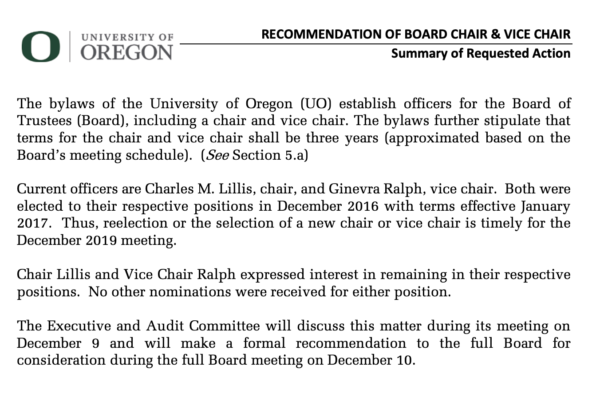
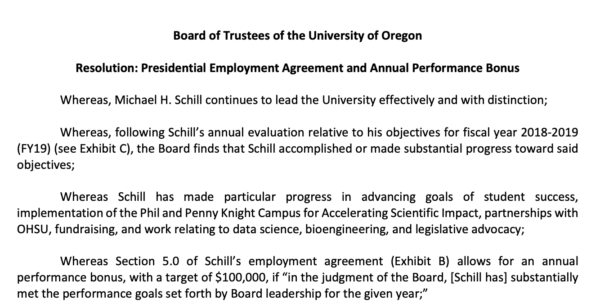
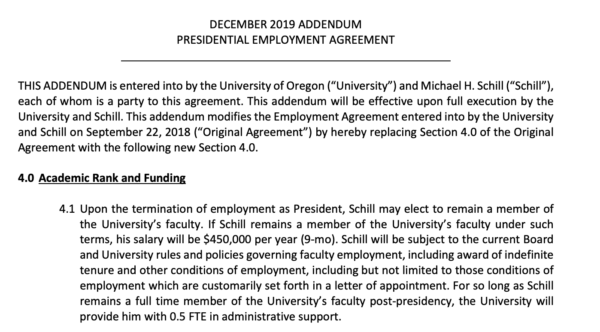

“social justice snowflakes”
I wish that guy was in my classes, a student that is
actually awake …
Well Coach Cristobal won the conference and is going to the Rose Bowl. Harbaugh should do something with his life. Like accomplish something. Fucking Dumbass loser.
Yes, cousin Jim did have a tough year at Michigan but he tries hard.. And please stick to the one cuss-word per comment limit.
In my opinion, Schill has a mixed record, with some notable achievements, but real problems erupting.
The improvement in graduation rates is a big accomplishment. A big national issue, and UO has done well! As is the apparent increase in research faculty and research funding. And of course, scoring the “Knight Campus.” He has a lot to crow about.
On the other hand, the finances of the University — the “business model” — looks very precarious to me. Enrollment dropping, covered by unsustainable tuition increases. A failing business. The relations with the State none too good — never were — but how can UO be last in funding per student? How is it that the Board is not making this a big issue? The financial independence certainly hasn’t worked out very well — it is not real, since tuition is still controlled by the state, and besides, UO is reaching and passing market limits.
No big big new endowment from anyone in a position to make it happen.
What about “administrative bloat”? That would really be worth looking into, if the Board were up to doing its job, or any job.
The bottom line seems to be, if Schill is planning to move, he should probably do it soon, before the floor here starts collapsing. Because I don’t see a way out.
As far as the “social justice war” issue — UO has become, along with a lot of places — completely occupied by the SJW crowd. The “thought partners” business just the tip of it. In Oregon, that may play OK, at least for now. In much of the country, it is making many people furious.
If that guy Joe wants to make sure he gets smarter not dumber — he should take a class with me.
By comparison to Schill:
https://www.insidehighered.com/news/2008/07/16/why-president-turns-down-bonus
Why a President Turns Down a Bonus
Decision by leader at Louisville raises question of whether such moves are meaningful gestures or just symbolism.
James Ramsey had specific goals in his contract as president of the University of Louisville, and he met just about every one, entitling him, trustees said, to a bonus of up to $113,857 – 25 percent of his base salary. In light of his state’s financial hardships and their impact on his institution, however, Ramsey recently decided not to accept the bonus. Now, a decision that some view as purely symbolic is being viewed by others on his campus as a show of solidarity in the midst of a university budget constrained by state cuts.
“At the end of the day, I asked to be treated just like everybody else,” said Ramsey, who will receive a $700 raise instead of a larger bonus, the same percentage all full-time faculty and staff at the university will receive as a result of this year’s 1 percent salary pool increase. “This was a tough budget year for us. I don’t want the attention to be focused on me.”
Of course it’s symbolism, but not “just” symbolism, and it’s far from meaningless. I recall about a decade back when the state was facing its own financial meltdown amidst the national one, and classified staff were forced to take a few years of furloughs to help balance the sheet. Was it “just” symbolism that the university faculty* voted to – voluntarily – take their own furloughs, too, in solidarity and for the good of the order? It certainly was not meaningless. And, by everyone pitching in and taking a hit, it certainly endeared the institution to state policymakers…
* At a school downstream of the UO
Administrators at a school downstream also took furloughs during that period. I was one of them. Had furloughs for nearly 4 years as an administrator there.
I blame the unions that we were only able to give Schill a measly $100,000 bonus this year. Quit being so greedy people!
UO is overleveraged. Big trouble is on the horizon.
Oh and why does it cost $23M to renovate one floor of a science building?
Overleveraged? Surely the bond-rating agencies would have caught that, like they did before the mortgage bond crisis. In any case I’m not sure how you short a university. I’m being sarcastic. UO has buckets of money – just look at how much we can blow on the Ducks and Hayward!
That does seem like some expensive labs. If you dig up some comparator data please post links.
This one cost $66.6M for 100K sqft.
https://news.clas.ufl.edu/corner-of-buckman-drive-and-university-avenue/
Many good renos are cheaper than a rebuild.